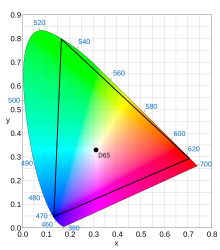Rec. 2100
ITU-R Recommendation BT.2100,more commonly known by the abbreviationsRec. 2100orBT.2100,introducedhigh-dynamic-rangetelevision (HDR-TV) by recommending the use of theperceptual quantizer(PQ [SMPTE ST 2084]) orhybrid log–gamma(HLG)transfer functionsinstead of the traditional "gamma"previously used forSDR-TV.[1][2]
It defines various aspects of HDR-TV such asdisplay resolution(HDTVandUHDTV),frame rate,chroma subsampling,bit depth,color space,color primaries,white point,andtransfer function.[3][4]It was posted on theInternational Telecommunication Union(ITU) website on July 4, 2016.[3][4]Rec. 2100 uses awide color gamut(WCG) which is the same asRec. 2020's.[4]
Technical details[edit]
Transfer functions[edit]
Rec. 2100 defines two sets of HDRtransfer functionswhich areperceptual quantization(PQ) andhybrid log-gamma(HLG).[3]HLG is supported in Rec. 2100 with a nominal peakluminanceof 1,000 cd/m2and a systemgammavalue that can be adjusted depending on background luminance.[3]For a reference viewing environment the peak luminance of display should be 1000 cd/m2or more for small area highlights and the black level should be 0.005 cd/m2or less.[3]The surround light should be 5 cd/m2and be neutral grey atstandard illuminantD65.[3]
Within each set, the documented transfer functions include an:
- electro-optical transfer function (EOTF) which maps the non-linear signal value into display light
- opto-optical transfer function (OOTF) which maps relative scene linear light to display linear light
- opto-electronic transfer function (OETF) which maps relative scene linear light into the non-linear signal value
System colorimetry[edit]

Rec. 2100 uses the samecolor primariesasRec. 2020which is aWide Color Gamut.[3][4]
| Color space | White point | Primary colors | ||||||
|---|---|---|---|---|---|---|---|---|
| xW | yW | xR | yR | xG | yG | xB | yB | |
| ITU-R BT.2100 | 0.3127 | 0.3290 | 0.708 | 0.292 | 0.170 | 0.797 | 0.131 | 0.046 |
Resolution[edit]
Rec. 2100 specifies three resolutions of1920 × 1080( "Full HD" ),3840 × 2160( "4K UHD" ), and7680 × 4320( "8K UHD" ).[3]These resolutions have anaspect ratioof16:9and use squarepixels.[3]
Frame rate[edit]
Rec. 2100 specifies the following frame rates: 120p, 119.88p, 100p, 60p, 59.94p, 50p, 30p, 29.97p, 25p, 24p, 23.976p.[3]Onlyprogressive scanframe rates are allowed.[3]
Digital representation[edit]
Rec. 2100 specifies a bit depth of either 10-bits per sample or 12-bits per sample, with either narrow range or full range color values. A future-use and intermediate linear RGB format using IEEE 16 bit floating point representation for each channel is also specified. For narrow range color, 10-bit per sample signals use video levels where theblack levelis defined as 64, achromaticgray levelas 512 and the nominal peak as 940 in RGB, Y, and I encoding and 960 in Cb/Cr, and Ct/Cp component encoding. 12-bit per sample signals define 256 as the black level, 2048 as the gray level and the nominal peak is 3760 in RGB, Y, and I component encoding and 3840 in Cb/Cr, and Ct/Cp component encoding. Narrow range signals may extend below black or above peak white (super-black and super-white respectively), but must always be clipped to the signal range of 4-1019 for 10-bit signals or 16-4079 for 12-bit signals.[3]
Signal formats[edit]
Rec. 2100 specifies the use of RGB, YCbCr, and ICtCp.[3]ICtCpprovides an improved color representation that is designed for high dynamic range (HDR) and wide color gamut signals (WCG).[3][5]
Luma coefficients[edit]
Rec. 2100 allows forRGB,YCbCr,andICtCpsignal formats with 4:4:4, 4:2:2, and 4:2:0chroma subsampling.[3]Rec. 2100 specifies that if aluma (Y') signalis made that it use the same matrix coefficients asRec. 2020:0.2627 for red, 0.678 for green, and 0.0593 for blue (derived from BT.2020 primaries and white point).[3]
Chroma sample location[edit]
Before Rec. BT.2020 thechroma sample locationthat was in use was center left. But in H.265 (2018-02) top-left chroma siting was mandated for BT.2020-2 and BT.2100-1, that must be described in VUI (video usability information) as such. First value of VUI should be 2 for top-left chroma and 0 for center left. Blu-ray also uses top-left chroma for HDR, including for Dolby Vision.
References[edit]
- ^"BT.2100: Image parameter values for high dynamic range television for use in production and international programme exchange".www.itu.int.Retrieved2021-02-04.
- ^"BT.1886: Reference electro-optical transfer function for flat panel displays used in HDTV studio production".www.itu.int.Retrieved2021-02-04.
- ^abcdefghijklmnopq"BT.2100: Image parameter values for high dynamic range television for use in production and international programme exchange".International Telecommunication Union. 2018-07-12.Retrieved2019-01-05.
- ^abcd"ITU announces BT.2100 HDR TV standard".FlatpanelsHD.Rasmus Larsen. 2016-07-05.Retrieved2016-07-26.
- ^"ICtCp Dolby White Paper"(PDF).Dolby.Retrieved2016-04-20.
External links[edit]
- ITU-R Recommendation BT.2100
- ITU-R BT.2390– A Report byITUproviding background information onHDRin general, and for theperceptual quantization(PQ) andhybrid log–gamma(HLG) HDRsignalparameters specified in the Rec.2100
